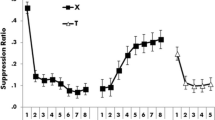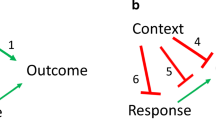Abstract
Pupillary dilation of five groups of 10 subjects each was conditioned by pairing an auditory CS and an electric UCS for nine trials. Two additional groups of 10 subjects each served as controls for pseudoconditioning and adaptation during conditioning. At the onset of the six extinction trials, four of the five conditioned groups were given different conditions designed to induce awareness of the termination of the UCS if cognition governed extinction. The fifth conditioned group was given conventional extinction trials as a control. The four cognition-inducing conditions resulted in complete one-trial extinction supporting a one-rather than a two-factor explanation of this phenomenon. The five conditioned groups demonstrated complete one-trial acquisition as did also one of the two control groups given false expectation of a CS-UCS. This suggests that acquisition was also completely controlled by cognition.
Similar content being viewed by others
References
BAER, P. E., & FUHRER, M. J. 1970. Cognitive processes in the differential trace conditioning of electrodermal and vasomotor activity. Journal of Experimental Psychology, 84, 176–178.
BREWER, W. F. 1974. There is no convincing evidence for operant or classical conditioning in adult humans. W. B. Weiner & D. S. Palermo (Eds.), Cognition and the symbolic processes. Hillsdale, N. J.: Lawrence Erlbaum Associates.
BRIDGER, W. H., & MANDEL, I. J. 1965. Abolition of the PRE by instructions in GSR conditioning. Journal of Experimental Psychology, 69, 476–482.
CHATTERJEE, B., & ERIKSEN, C. W. 1962. Cognitive factors in heart rate conditioning. Journal of Experimental Psychology, 64, 272–279.
DAWSON, M. E., & GRINGS, W. W. 1968. Comparison of classical and relationallearmng. Journal of Experimental Psychology, 76, 227–231.
GERALL, A. A., SAMPSON, P. B., & BOSLOV, G. L. 1957. Classical conditioning of human pupillary dilation. Journal of Experimental Psychology, 54, 467–474.
GRINGS, W. W., & LOCKHART, R. A. 1963. Effects of “anxiety-lessening”, instructions and differential set development on the extinction of GSR. Journal of Experimental Psychology, 66, 292–299.
MANDEL, I. J., & BRIDGER, W. H. 1967. Interaction between instructions and ISI in conditioning and extinction of the GSR. Journal of Experimental Psychology, 74, 36–43.
MORGENSON, D. F., & MARTIN, I. 1969. Personality, awareness and autonomic conditioning. Psychophysiology, 5, 536–547.
WICKENS, D. D., ALLEN, C. K., & HILL, F. A. 1963. Effect of instructions and UCS strength on extinction of the conditioned GSR. Journal of Experimental Psychology, 66, 235–240.
WILSON, G. D. 1968. Reversal of differential GSR conditioning by instructions. Journal of Experimental Psychology, 76, 491–493.
Author information
Authors and Affiliations
Rights and permissions
About this article
Cite this article
Jennings, L.B., Crosland, R., Loveless, S. et al. Cognitive Control of Extinction of Classically Conditioned Pupillary Response. Psychol Rec 28, 193–205 (1978). https://doi.org/10.1007/BF03394527
Published:
Issue Date:
DOI: https://doi.org/10.1007/BF03394527




